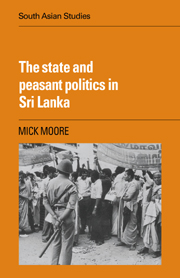Book contents
- Frontmatter
- Contents
- List of maps
- List of tables
- Acknowledgments
- Glossary of Sri Lankan terms
- Maps
- 1 Puzzles and agendas
- 2 Methods, scope and elaborations
- 3 Crown lands
- 4 Land reform
- 5 Pricing and agricultural services
- 6 Categorising space: urban–rural and core–periphery
- 7 A smallholder interest or smallholder interests?
- 8 Rural consciousness
- 9 Ethnic conflict and the politics of the periphery
- 10 The Sri Lankan polity
- 11 Concluding remarks
- Appendix 1 Results of general elections, 1947–77: percentage of parliamentary seats won
- Appendix 2 The myth of the plantation impact on the Sinhalese village: two accounts
- Notes
- Bibliography
- Index
- CAMBRIDGE SOUTH ASIAN STUDIES
9 - Ethnic conflict and the politics of the periphery
Published online by Cambridge University Press: 05 March 2012
- Frontmatter
- Contents
- List of maps
- List of tables
- Acknowledgments
- Glossary of Sri Lankan terms
- Maps
- 1 Puzzles and agendas
- 2 Methods, scope and elaborations
- 3 Crown lands
- 4 Land reform
- 5 Pricing and agricultural services
- 6 Categorising space: urban–rural and core–periphery
- 7 A smallholder interest or smallholder interests?
- 8 Rural consciousness
- 9 Ethnic conflict and the politics of the periphery
- 10 The Sri Lankan polity
- 11 Concluding remarks
- Appendix 1 Results of general elections, 1947–77: percentage of parliamentary seats won
- Appendix 2 The myth of the plantation impact on the Sinhalese village: two accounts
- Notes
- Bibliography
- Index
- CAMBRIDGE SOUTH ASIAN STUDIES
Summary
Introduction
This chapter brings together two issues which were introduced in Chapters Seven and Eight. In Chapter Seven it was suggested that in explaining the absence of an explicitly agrarian party or political programme, one should look especially closely at the Dry Zone periphery. For this contains a population apparently united around a clear objective interest in high domestic food prices. In Chapter Eight it was shown that the kinds of collective identities which have helped stimulate agrarian political movements and policy demands in India and Malaysia have not played an equivalent role in Sri Lanka. Yet it was at the same time noted that ethnic conflict has been a salient feature of Sri Lankan politics. Given the symbolic place of the peasantry in the Sinhalese nationalist myth, one needs to ask why the Sinhalese ethnic identity has not underpinned a Sinhalese agrarian political movement extending its scope beyond cultural, religious and linguistic issues to those of agriculture and economic policy.
The main argument in this chapter is that the Sinhalese versus non-Sinalese ethnic conflict – especially that of the Sinhalese versus Tamils – has probably played an important role in preventing the emergence of an agrarian movement in the Dry Zone. For the ethnic divide has fragmented the Dry Zone surplus-food producers and has left the Sinhalese farmers in particular without the leadership that most large surplus-paddy producers could have given – for the latter tend to be Muslims and Tamils.
- Type
- Chapter
- Information
- The State and Peasant Politics in Sri Lanka , pp. 191 - 201Publisher: Cambridge University PressPrint publication year: 1985



